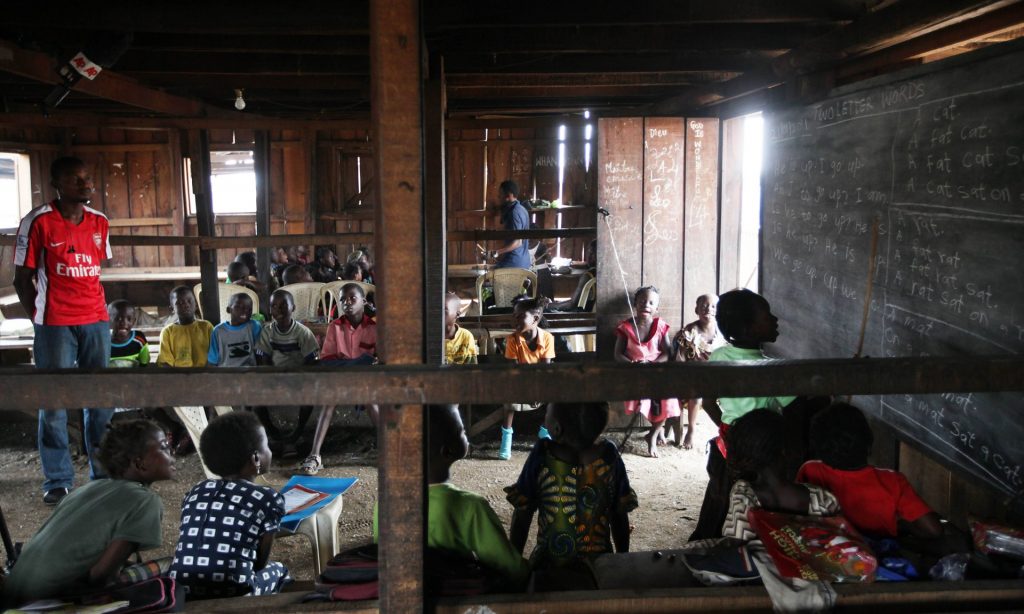
Photograph: Sunday Alamba/AP
For the first time in history we can succeed in providing education for all children and young people. If we put education first, we will gain multiple benefits in terms of development and prosperity.
Political will is paramount, and must be backed by the right policies, additional funds and innovative partnerships that include all interested parties.
As prime minister of Norway and co-chair of the UN sustainable development goals advocacy group, I am doing my best to ensure this will become a reality. This week, the international commission on financing global educati
on opportunity gathers in Oslo for its last meeting before making recommendations to the UN secretary general in September.
“Our progress as a nation can be no swifter than our progress in education,” John F Kennedy once stated in a message to the US Congress. That statement, made 55 years ago, remains just as true today, and applies to all countries regardless of their social and economic development. We all face the challenges of adapting to a rapidly changing global economy. Knowledge and innovation are probably more essential than ever before. Few – if any – investments are likely to pay higher returns over time. There is a business case for education in every corner of the world.
Take job creation and innovation.
Worldwide, there is a huge need for more and better jobs, especially with youth unemployment rising. The International Labour Organisation estimates that 600 million new jobs will be needed by 2020 in order to address global unemployment and keep up with demographic developments. Countries are dealing with this challenge in different ways, but the starting point for all of us is our education system. Well-functioning schools with qualified and motivated teachers are a prerequisite for success. Moreover, innovation and use of new technology are necessary to deliver the qualifications required by a knowledge-based labour market in constant flux.
Take gender equality and health.
If young girls are able to access and complete primary and secondary education, the number of child marriages and early pregnancies will go down, while the opportunity for women to participate in society and contribute directly to the economy will increase. Education and health are directly linked in this regard: for example, in many low- and middle income countries, increased access to education for girls has led to a significant reduction in infant mortality.
Last year, world leaders adopted the sustainable development goals. SDG 4, aiming at quality education for all by 2030, is central precisely because of its impact on health and a range of other goals and targets.
Our common task is to provide and protect quality education for the 124m children and adolescents who remain out of school, and to ensure improved learning outcomes for those who are in school. According to the UN, an estimated 125 million children are not learning basic skills even though they have spent at least four years in school.
SDG 4 may seem overwhelmingly ambitious. Yet the number of children and young people not attending school has almost halved since the turn of the century and, thanks in part to the millennium development goals, in most countries there are now as many girls as boys in primary school.
When my government took office almost three years ago, we decided to put education at the forefront of Norway’s development policy. We are in the process of doubling development aid for education, emphasising in particular girls’ education, quality and learning outcomes, vocational training and education in emergencies and protracted crises.
Although we have increased humanitarian aid for education to 8%, four times the global average, the fact remains that 37 million children and adolescents are out of school due to crises and conflict. So far, the international community has done far too little in this field. We need to find better ways of bridging humanitarian and development aid, devising more initiatives such as the education cannot wait fund (pdf) – a scheme that makes provision for education in emergencies – launched at May’s world humanitarian summit in Istanbul.
Finance is a major barrier to reaching the education SDG. The total annual gap between available domestic resources and the amount necessary to reach the new education targets has been projected to average $39bn (£28bn) between 2015 and 2030.
Mobilising domestic resources is key. While the main responsibility for education rests with national governments, development aid continues to play a role, especially in the least developed countries, in fragile situations, and for marginalised groups. The downward trend in development aid for education over the past year must be reversed to ensure that no one is left behind. More of the same is, however, not sufficient. We must promote innovation and try out new approaches, such as results-based financing. The private sector should be actively involved, alongside governments, NGOs, international organisations and other stakeholders, not least when it comes to vocational training.
We need to develop a renewed and compelling investment case for education, and a financial pathway leading to universal access to quality education. That is why the international commission on financing global education, chaired by Gordon Brown, the UN special envoy for global education, was established last summer at the Oslo summit on education for development. The UN secretary general has made it clear that he will act upon the commission’s recommendations. So should we all.
Reaching all children and young people with quality education may be a daunting challenge, but we can make significant progress if decision-makers step up to the plate, together with teacher unions, international organisations, the private sector, civil society and others.
Investing in education means investing in society at large. If we put education first, our global society will reap significant gains in terms of development and prosperity.

